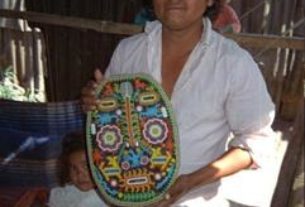Although the economy of Nueva España was eventually transformed by the introduction of European crops, draft animals and technology, excessive controls stifled the initial growth of its industry and commerce. To secure its profits, the Crown held monopolies on products such as salt, gunpowder, mercury, pulque and tobacco. Economic activities deemed to compete with Spanish industry were severely restricted or prohibited altogether. The few industries that were permitted — tanning and weaving of coarse cloth, for example — were so tightly regulated that they were seldom profitable.
On the other hand, following the discovery of valuable mineral deposits Spain actively fostered the mining industry. Between 1546 and 1548 vast silver deposits were uncovered in Zacatecas, which swiftly grew to be the country’s third largest city — surpassed only by the capital and Puebla. Booms later hit Guanajuato, San Luis Potosi, Pachuca and Taxco. By the early 17th Century, Zacatecas was producing a third of Mexico’s silver and a fifth of the total world supply.
As early as 1536 copper, silver and cold coins were being milled in Mexico City at the Western Hemisphere’s first mint. Silver coins in denominations of Ocho Reales were first struck in 1572. Better known as the Spanish Dollar, this hefty bit of change was widely circulated as legal tender throughout Europe and the Orient. The widespread practice of cutting the coin into smaller parts gave rise to the terms “pieces of eight” and “two bits.” The dollar sign derives from the pillars of Hercules designed for some issues of the coin. By the end of the 18th Century Spanish dollars made up the bulk of England’s treasury. Counter-marked with new seals, the coins were converted into official British currency.
Transporting New Spain’s immense mineral wealth became something of a security nightmare. Masked bandits repeatedly ambushed mule trains bound for Mexico City, Acapulco or Veracruz. A greater threat were the English, French and Dutch pirates who prowled the Caribbean in search of Spanish galleons ripe for plunder.
Mining however was a secondary enterprise compared to agriculture. Indispensable to sustain a growing colonial society, farming and ranching quickly became New Spain’s principal occupations. Cattle, sheep, and other livestock imported from Spain were driven north where ranchers settled across the open ranges near northern mining centers. Wheat, sugar cane, citrus and other fruits were introduced to more fertile lands. Again there were restrictions. Although wine and olive oil were staples of the Spanish diet, colonists were prohibited from planting vineyards and olive groves to protect the interests of farmers back in the homeland. The cultivation of mulberry bushes was also banned to safeguard to Spain’s silk industry.
Initially, agricultural production was primarily geared for domestic consumption, but some of New Spain’s unique products proved to have considerable export value. Cochineal and indigo dyes, derived from indigenous species, were in high demand for Europe’s burgeoning textile industry. Cacao became an important cash crop once the Aztec delicacy xocoatl (chocolate) became all the rage in Continental society. Vanilla, sugar, henequén, cotton and tobacco also become lucrative crops as the demand for these products increased in markets abroad.
Considerable revenue was also generated through Spain’s complex duty and tax system. All goods imported to the colonies were carried by Spanish ships manned by Spanish crews. The collection of duties was secured by channeling the annual voyage of the Spanish fleet to Veracruz. Similarly, the Manila Galleon, loaded with luxury goods from the Orient destined for Spain, disembarked once a year at Acapulco. The limited supply and high cost of essential imported merchandise spurred some enterprising colonists to begin producing substitutes. For example, locally-brewed beer became an increasingly popular beverage in lieu of expensive Spanish wines. In addition, the demand for contraband merchandise fomented a budding black market.
The economic picture began to change at the dawn of the 18th century when the Bourbon monarchs ascended the Spanish throne. Reforms in Spain’s government and sweeping changes in its policies towards the colonies were instigated during the 1759-1788 reign of Charles III. Trade restrictions were greatly reduced. The Crown permitted New Spain to open new ports in Campeche and Yucatan and finally sanctioned free trade between other ports both in Spain and throughout the Americas.
Meanwhile, the Church had also begun to prosper. As most of the indigenous people had been Christianized during the first wave of mendicant friars, the clerics who arrived later took more interest in providing for the spiritual needs of wealthy Spanish settlers, many of whom in turn bequeathed their worldly goods to the Church. By the end of the 18th Century over half of New Spain’s land and close to two thirds of the money in circulation had fallen into the hands of the Church.
By then Nueva España was the richest of all of Spain’s overseas territories. Ten generations of colonists had enjoyed 300 hundred years of relative peace — a period that surpassed the duration of the Aztec Empire by a full century. But much of colonial society had tired of Spain’s unrelenting extreme self-interest, as manifested by export controls and heavy taxation detrimental to internal economic development. The colony was well established and quite capable of self-government. At the same time political upheavals in Europe began to shake Spain. The philosophy behind the French and American revolutions spread to the Americas, acting as a catalyst for social and political unrest. Nueva España was now ripe for independence.


